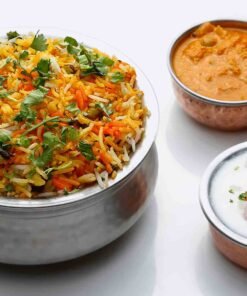Biryani is a mixed rice dish, mainly popular in South Asia. It is made with rice, some type of meat (chicken, goat, pork, lamb, beef, prawn, or fish) and spices. To cater to vegetarians, in some cases, it is prepared by substituting vegetables or paneer for the meat. Sometimes eggs and/or potatoes are also added.
Biryani has been a part of Hyderabadi cuisine tradition for nearly 400 years. It is believed to have been served directly from Persia. Hyderabadi Dum Biryani, the key dish of the royal kitchen came to India after Emperor Aurangzeb appointed Nizam-Ul-Mulk as the new ruler of Hyderabad.
There are many stories about its origin, but the most popular one links it to Nawab Asaf-ud-Daulah, who was the wazir or ruler of Oudh/Awadh during the late 1700s. In 1784, during the great famine, the Nawab introduced a charitable initiative for his people with a food-for-work programme.
“Dum” derives from “Dumpukht” meaning air-cooked or baked. Dum Chicken Biryani is traditionally cooked over wood or charcoal fire – A rice filled handi or earthen pot, layered in harmony with meat and spices, covered with a lid and sealed with dough.
Simply put, biriyani is a spiced mix of meat and rice, traditionally cooked over an open fire in a leather pot. It is combined in different ways with a variety of components to create a number of highly tasty and unique flavor combinations. The word “biriyani” itself comes from the word “birian,” a Persian term which translates to “fried before cooking.” Indeed, the roots of this dish have been traced by notable historians to modern day Persia, with appearances in notes under various names as early as 2 CE. The biriyani recipe was then much simplified in order to keep it viable during travel.
Once the dish reached India, it blossomed into something entirely new. The story goes that Mumtaz Mahal, a Queen of Shah Jahan, visited an army barrack and found the soldiers there to be heavily undernourished. She demanded the barrack’s cook provide the soldiers with a dish that was nutritious and had all the meat, rice, and spices needed to restore their energy. According to legend, this is how the dish first came to India. As various regions across Southern Asia adopted the recipe, it grew and changed to express cultures’ values; leading to the diverse selection of biriyani dishes that exist today.



